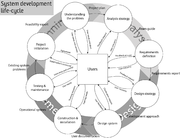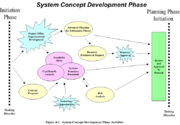User:Vtaylor/k8engineering/Systems
Infrastructure provides the basic physical systems and structures essential to the operation of a society or enterprise. in our technology innovation perspective: energy, transport, communication and water infrastructures.
System - a group of interacting, interrelated, or interdependent elements forming a complex whole
- natural - water cycle, solar system
- built - city water system, car,
- hybrid - enhancing a natural system with technology and engineering - dam
Systems Engineering - a field of engineering that deals with complex engineering projects which should be designed and managed over the life cycle of the project. Systems engineering deals with work-processes and tools to handle projects. It applies both technical and human-centered disciplines such as control engineering, industrial engineering, organizational studies, and project management.
- logistics
- coordination of different teams
- automatic control of machinery
system life cycle usually has seven phases. However, the system life cycle is different for different industries, products and customers.
- discovering system requirements,
- investigating alternatives
- full-scale engineering design
- implementation
- integration and test
- operation, maintenance and evaluation
- retirement, disposal and replacement.
Engineering ideas
- customer needs, required functionality, documentation, design synthesis, system validation, operations, performance, test, manufacturing, cost, schedule, decision theory, statistics, optimization
Areas of interest
- project life cycle
- teamwork
- scoping and concept of operations
- requirements
- trade studies
Q: Find examples of systems and the development life-cycle process used for these projects
Learn more...
- Systems Engineering -
- Survey of Systems Engineering - the value and purpose of systems engineering, the systems engineering project life cycle, and relate the roles of systems engineers in complex space missions. You will also identify the roles and concepts of operations, requirements, and trade studies in the project lifecycle and demonstrate the ability to apply these concepts to a real NASA mission.

